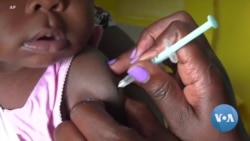ອົງການອະນາໄມໂລກໄດ້ອະນຸມັດຢາວັກຊີນຕ້ານໄຂ້ຍຸງຊະນິດທີສອງໃນວັນຈັນແລ້ວນີ້. ພວກເຂົາເຈົ້າຫວັງວ່າ ຢາຊະນິດໃໝ່ຈະໄດ້ຮັບການນຳໃຊ້ຢ່າງໄວວາ ໃນບັນດາປະເທດທົ່ວທະວີບອາຟຣິກາອີກບໍ່ເທົ່າເດືອນຂ້າງໜ້ານີ້. ເຮັນຣີ ຣິຈແວລ ມີລາຍງານຈາກນະຄອນຫຼວງລອນດອນ, ເຊິ່ງ ທິບສຸດາ ມີລາຍລະອຽດມາສະເໜີທ່ານ.
ຢາວັກຊີນຕ້ານໄຂ້ຍຸງຊະນິດໃໝ່ ເຊິ່ງທີ່ຮູ້ຈັກໃນນາມ R21, ໄດ້ຖືກພັດທະນາໂດຍມະຫາວິທະຍາໄລອັອກສຝອດ (Oxford) ຂອງອັງກິດ, ພ້ອມດ້ວຍສະຖາບັນເຊຣໍາ (Serum) ຂອງອິນເດຍ. ມັນໄດ້ຖືກນໍາອອກໃຊ້ແລ້ວໃນປະເທດການາ ແລະ ເບີກິນາ ຟາໂຊ.
ອົງການອະນາໄມໂລກໄດ້ອະນຸມັດຢາດັ່ງກ່າວ ໃນວັນຈັນແລ້ວນີ້ ເຊິ່ງໄດ້ແຜ້ວທາງໃຫ້ມີການຜະລິດໃນຂອບເຂດທີ່ກວ້າງຂວາງກວ່າເກົ່າ.
ດຣ. ເຕໂດຣສ ອັດດານົມ ເກເບຣເຢຊຸສ (Tedros Adhanom Ghebreyesus), ຜູ້ອໍານວຍການໃຫຍ່ຂອງອົງການອະນາໄມໂລກ ກ່າວວ່າ:
“ໃນຂົງເຂດທີ່ມີການແຜ່ລະບາດຕາມລະດູການ, ມັນໄດ້ຫຼຸດຜ່ອນກໍລະນີຕິດເຊື້ອທີ່ມີອາການຂອງມາເລເຣຍລົງ 75 ເປີເຊັນ ໃນ 12 ເດືອນ ລຸນຫຼັງການສັກຢາວັກຊີນຮອດສາມຄັ້ງ. ການສັກຢາຄັ້ງທີສີ່ ສັກໃຫ້ອີກນຶ່ງປີຫຼັງຈາກການສັກສາມຄັ້ງທີ ສະແດງໃຫ້ເຫັນວ່າຍັງສືບຕໍ່ໃຫ້ການຄຸ້ມຄອງຄົງທີ່."
ອົງການ WHO ໄດ້ອະນຸມັດຢາວັກຊີນມາລາເຣຍຄັ້ງທຳອິດໃນປີ 2021, ເຊິ່ງຮູ້ຈັກກັນໃນຊື່ RTS,S.
ດຣ. ເກເບຣເຢຊຸສ ກ່າວວ່າ:
“ໃນຖານະທີ່ເປັນນັກວິໄຈພະຍາດໄຂ້ມາລາເຣຍ, ຂ້າພະເຈົ້າເຄີຍຝັນເຖິງມື້ທີ່ພວກເຮົາຈະມີວັກຊີນປ້ອງກັນໄຂ້ຍຸງຊະສິດທີ່ປອດໄພ ແລະ ມີປະສິດທິພາບ. ປັດຈຸບັນນີ້ ພວກເຮົາມີຢາວັກຊີນສອງຊະນິດ.”
ອົງການ WHO ກ່າວວ່າ ມັນມີຄວາມແຕກຕ່າງເລັກນ້ອຍໃນປະສິດທິພາບລະຫວ່າງຢາວັກຊີນທັງສອງດັ່ງກ່າວ. ແຕ່ວັກຊີນ R21 ໃໝ່ນີ້ ແມ່ນມີລາຄາຖືກກວ່າທີ່ຈະຜະລິດ, ປະມານສອງຫາສີ່ໂດລາຕໍ່ໂດສ, ເຊິ່ງຄົນເຈັບແຕ່ລະຄົນຕ້ອງການສີ່ໂດສ ປະມານເຄິ່ງຫນຶ່ງຂອງລາຄາຢາວັກຊີນ RTS,S.
ວັກຊີນໃໝ່ຍັງສາມາດຜະລິດໄດ້ໃນປະລິມານຫຼາຍກວ່າເກົ່າ. ສະຖາບັນ Serum ຂອງປະເທດອິນເດຍແມ່ນຢູ່ໃນຂັ້ນຕອນທີ່ຈະຜະລິດ 100 ລ້ານໂດສຕໍ່ປີ, ໂດຍມີແຜນການທີ່ຈະຜະລິດຢາດັ່ງກ່າວອອກມາສອງເທົ່າ.
ນັກຊ່ຽວຊານເຕືອນວ່າ ມັນຈະບໍ່ທໍາລາຍໄຂ້ມາລາເຣຍດ້ວຍໂຕຂອງມັນເອງ, ແລະຈໍາເປັນຕ້ອງມີມາດຕະການປ້ອງກັນອື່ນໆອີກ ລວມທັງມຸ້ງກັນຍຸງ.
ທ່ານນາງອາຊຣາ ການີ (Azra Ghani), ນັກລະບາດວິທະຍາ ຢູ່ທີ່ມະຫາ ວິທະຍາໄລ ອິມເພີຣຽລ (Imperial) ລອນດອນ ກ່າວຜ່ານຊູມວ່າ:
"ດັ່ງນັ້ນ ປະສິດທິພາບທີ່ເພີ້ມຂຶ້ນຂອງວັກຊີນນີ້ ແມ່ນຢູ່ກັບການມີຢູ່ໃນການແຊກແຊງທີ່ສໍາຄັນແທ້ໆນີ້. ອັນທີສອງ ແມ່ນບາງສິ່ງບາງຢ່າງທີ່ເອີ້ນວ່າການປ້ອງກັນທາງເຄມີ, ນັ້ນ ແມ່ນການສະຫນອງຢາໃຫ້ແກ່ເດັກນ້ອຍໃນເຂດທີ່ມີຄວາມສ່ຽງສູງ ໂດຍສະເພາະໃນບ່ອນທີ່ມີພະຍາດໄຂ້ຍຸງຕາມລະດູການ.”
ມີການຄາດຄະເນວ່າ ມີຜູ້ທີ່ເປັນພະຍາດໄຂ້ຍຸງ 247 ລ້ານກໍລະນີໃນປີ 2021, ເຊິ່ງເພີ່ມຂຶ້ນໜ້ອຍໜຶ່ງຈາກປີກ່ອນໜ້ານັ້ນ, ແລະມີຜູ້ເສຍຊີວິດ 619 ພັນຄົນ ໂດຍສ່ວນໃຫຍ່ແມ່ນເດັກນ້ອຍ ທີ່ອາໄສຢູ່ໃນເຂດໃຕ້ທະເລຊາຍຊາຮາຣາຂອງອາຟຣິກາ.
ທ່ານນາງ ການີ ກ່າວຜ່ານຊູມວ່າ:
"ພວກເຮົາຫວັງວ່າ ໂດຍການແນະນໍາຢາວັກຊີນໃຫມ່ນີ້, ພວກເຮົາສາມາດສ້າງຄວາມປະທັບໃຈຢູ່ໃນຈຸດນີ້ ແລະເຮັດໃຫ້ພວກເຮົາກັບຄືນສູ່ເປົ້າຫມາຍ ເຊິ່ງວາງອອກມາໂດຍອົງການ WHO ເພື່ອຫຼຸດຜ່ອນໄຂ້ຍຸງລົງ 90 ເປີເຊັນ ໃນປີ 2030."
ອົງການ WHO ຍັງໄດ້ອະນຸມັດຢາວັກຊີນໃໝ່ໃນວັນຈັນມື້ນີ້ ເພື່ອຕ້ານພະຍາດໄຂ້ເລືອດອອກ ເຊິ່ງເປັນພະຍາດທີ່ເກີດຈາກຍຸງອີກຊະນິດໜຶ່ງທີ່ພົບເລື້ອຍໆ ໃນບັນດາປະເທດເຂດຮ້ອນອາເມລິກາລາຕິນ ແລະບັນດາປະເທດ ໃນຂົງເຂດເອເຊຍ.
ຢາດັ່ງກ່າວ, ຜະລິດໂດຍ ບໍລິສັດທາເກດະ (Takeda) ຂອງຍີ່ປຸ່ນ, ມີປະສິດຕິພາບໃນການປ້ອງກັນ ບໍ່ໃຫ້ຄົນເຂົ້າໂຮງຫມໍປະມານ 84 ເປີເຊັນ ໃນການທົດລອງທາງດ້ານຄລີນິກ.
The World Health Organization approved a second malaria vaccine Monday. It’s hoped the new drug will quickly be rolled out in countries across Africa in the coming months. Henry Ridgwell reports from London.
A new malaria vaccine — known as R21 — was developed by Britain’s Oxford University, along with the Serum Institute of India. It is already in use in Ghana and Burkina Faso.
The World Health Organization approved the drug Monday – paving the way for its wider rollout.
Dr. Tedros Adhanom Ghebreyesus, World Health Organization Director-General.
“In areas with seasonal transmission, it’s reduced symptomatic cases of malaria by 75% in the 12 months following a three-dose series of the vaccine. A fourth dose given a year after the third was shown to maintain protection.”
The WHO approved the first ever malaria vaccine in 2021, known as RTS,S.
Dr. Tedros Adhanom Ghebreyesus, World Health Organization Director-General.
“As a malaria researcher, I used to dream of the day when we would have a safe and effective vaccine against malaria. Now we have two.”
The WHO says there is little difference in effectiveness between the two vaccines. But the new R21 vaccine is cheaper to make – at around two to four dollars a dose, with each patient needing four doses – about half the price of RTS,S.
The new vaccine can also be made in much greater volumes. The Serum Institute of India is already in line to make 100 million doses a year, with plans to double that output.
Experts warn that it won’t beat malaria on its own, and that other preventative measures are needed — including mosquito nets.
Azra Ghani, Epidemiologist at Imperial College London, female, English, Zoom
“So this additional efficacy of the vaccine is in the presence of this really important intervention. The second is something known as chemo-prevention, that’s providing drugs to children in high-risk areas where malaria is particularly seasonal.”
There were an estimated 247 million cases of malaria in 2021, a small increase on the previous year, and 619-thousand deaths – mostly children in sub-Saharan Africa.
Azra Ghani, Epidemiologist at Imperial College London, female, English, Zoom.
“We do hope that by introducing this new vaccine, we can really make a dent in this and get us back on track to the goals which were set by the WHO to reduce malaria by 90 per cent by 2030.”
The WHO also approved a new vaccine Monday against dengue fever, another mosquito-borne disease common in tropical Latin American and Asian countries.
The drug, made by the Japanese firm Takeda, was about 84% effective in preventing people from being hospitalized in clinical trials.





